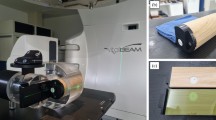Abstract
We evaluated the water-equivalent length (WEL) reproducibility due to variation in the external respiratory marker position when using a 4DCT scan in respiratory-gated charged-particle treatment. Two sets of pancreatic 4DCT data from two patients were acquired under free breathing conditions with 256-slice CT. The 4DCT data included two exhalation phases and the respiratory patterns in each patient differed, one being regular and the other irregular. The WEL calculation region is defined in the first respiratory cycle by two planes, one at the patient entrance surface and the other behind the target in the anterior–posterior (AP) and posterior–anterior (PA) directions. In the regular respiratory pattern, the WEL variation within the target region was less than 1.7 mm between the first and second exhalations in both AP and PA calculation directions. However, in the irregular breathing pattern, the respiratory amplitude at the second exhalation was 20% lower than that at the first exhalation; therefore, WEL variations from 8.1 to −9.1 mm and from 3.1 to −3.4 mm were observed within the target region in the AP and PA calculation directions, respectively. The WEL variation in the PA direction was smaller than that in the AP direction because the abdominal thickness is affected more in the AP direction. Respiratory pattern variation even affects WEL values in the respiratory-gated phase. This variation should be considered in treatment planning, and necessary improvements in respiratory reproducibility should be made.





Similar content being viewed by others
References
Mori S, Wolfgang J, Lu H, Schneider R, Choi NC, Chen GT. Quantitative assessment of range fluctuations in charged particle lung irradiation. Int J Radiat Oncol Biol Phys. 2008;70:253–61.
Mori S, Chen GT, Endo M. Effects of intrafractional motion on water equivalent pathlength in respiratory-gated heavy charged particle beam radiotherapy. Int J Radiat Oncol Biol Phys. 2007;69(1):308–17.
Minohara S, Kanai T, Endo M, Noda K, Kanazawa M. Respiratory gated irradiation system for heavy-ion radiotherapy. Int J Radiat Oncol Biol Phys. 2000;47(4):1097–103.
Ohara K, Okumura T, Akisada M, Inada T, Mori T, Yokota H, et al. Irradiation synchronized with respiration gate. Int J Radiat Oncol Biol Phys. 1989;17(4):853–7.
Kato H, Tsujii H, Miyamoto T, Mizoe JE, Kamada T, Tsuji H, et al. Results of the first prospective study of carbon ion radiotherapy for hepatocellular carcinoma with liver cirrhosis. Int J Radiat Oncol Biol Phys. 2004;59(5):1468–76.
Shea SA, Guz A. Personnalite ventilatoire—an overview. Respir Physiol. 1992;87(3):275–91.
Benchetrit G. Breathing pattern in humans: diversity and individuality. Respir Physiol. 2000;122(2–3):123–9.
Mageras GS, Yorke E, Rosenzweig K, Braban L, Keatley E, Ford E, et al. Fluoroscopic evaluation of diaphragmatic motion reduction with a respiratory gated radiotherapy system. J Appl Clin Med Phys. 2001;2(4):191–200.
Berbeco RI, Jiang SB, Sharp GC, Chen GT, Mostafavi H, Shirato H. Integrated radiotherapy imaging system (IRIS): design considerations of tumour tracking with linac gantry-mounted diagnostic x-ray systems with flat-panel detectors. Phys Med Biol. 2004;49(2):243–55.
Tsunashima Y, Sakae T, Shioyama Y, Kagei K, Terunuma T, Nohtomi A, et al. Correlation between the respiratory waveform measured using a respiratory sensor and 3D tumor motion in gated radiotherapy. Int J Radiat Oncol Biol Phys. 2004;60(3):951–8.
Seppenwoolde Y, Shirato H, Kitamura K, Shimizu S, van Herk M, Lebesque JV, et al. Precise and real-time measurement of 3D tumor motion in lung due to breathing and heartbeat, measured during radiotherapy. Int J Radiat Oncol Biol Phys. 2002;53(4):822–34.
Endo M, Mori S, Kandatsu S, Tanada S, Kondo C. Development and performance evaluation of the second model 256-detector row CT. Radiol Phys Technol. 2008;1:20–6.
Endo M, Mori S, Tsunoo T, Kandatsu S, Tanada S, Aradate H, et al. Development and performance evaluation of the first model of 4D CT-scanner. IEEE Trans Nucl Sci. 2003;50:1667–71.
Mori S, Endo M, Tsunoo T, Kandatsu S, Tanada S, Aradate H, et al. Physical performance evaluation of a 256-slice CT-scanner for four-dimensional imaging. Med Phys. 2004;31(6):1348–56.
Ford EC, Mageras GS, Yorke E, Rosenzweig KE, Wagman R, Ling CC. Evaluation of respiratory movement during gated radiotherapy using film and electronic portal imaging. Int J Radiat Oncol Biol Phys. 2002;52(2):522–31.
Giraud P, Yorke E, Ford EC, Wagman R, Mageras GS, Amols H, et al. Reduction of organ motion in lung tumors with respiratory gating. Lung Cancer. 2006;51(1):41–51.
Parker DL. Optimal short scan convolution reconstruction for fan beam CT. Med Phys. 1982;9(2):254–7.
Kanematsu N, Matsufuji N, Kohno R, Minohara S, Kanai T. A CT calibration method based on the polybinary tissue model for radiotherapy treatment planning. Phys Med Biol. 2003;48(8):1053–64.
Kubo HD, Wang L. Introduction of audio gating to further reduce organ motion in breathing synchronized radiotherapy. Med Phys. 2002;29(3):345–50.
Kini VR, Vedam SS, Keall PJ, Patil S, Chen C, Mohan R. Patient training in respiratory-gated radiotherapy. Med Dosim. 2003;28(1):7–11.
George R, Keall PJ, Kini VR, Vedam SS, Siebers JV, Wu Q, et al. Quantifying the effect of intrafraction motion during breast IMRT planning and dose delivery. Med Phys. 2003;30(4):552–62.
Furukawa T, Inaniwa T, Sato S, Tomitani T, Minohara S, Noda K, et al. Design study of a raster scanning system for moving target irradiation in heavy-ion radiotherapy. Med Phys. 2007;34(3):1085–97.
Noda K, Furukawa T, Fujisawa T, Iwata Y, Kanai T, Kanazawa M, et al. New accelerator facility for carbon-ion cancer-therapy. J Radiat Res (Tokyo). 2007;48(Suppl A):A43–54.
Author information
Authors and Affiliations
Corresponding author
About this article
Cite this article
Kumagai, M., Mori, S., Hara, R. et al. Water-equivalent pathlength reproducibility due to respiratory pattern variation in charged-particle pancreatic radiotherapy. Radiol Phys Technol 2, 112–118 (2009). https://doi.org/10.1007/s12194-008-0052-z
Received:
Revised:
Accepted:
Published:
Issue Date:
DOI: https://doi.org/10.1007/s12194-008-0052-z




